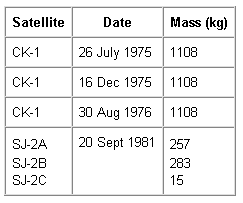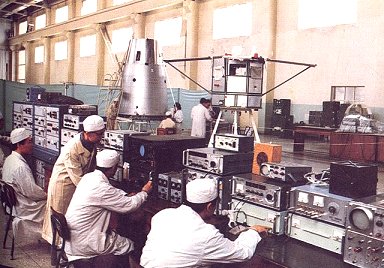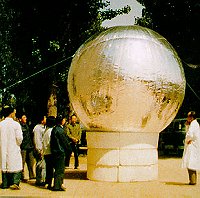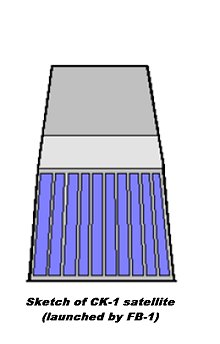The satellites launched by FB-1
Sven Grahn
 The
basic missile that became China's ICBM was developed at two places, Beijing
and Shanghai. The overall design of the two vehicles was the same, but
they were not compatible on subsystem level. The two rockets were also
used as satellite launch vehicles. The Beijing version of the rocket became
the CZ-2C and the Shanghai version was called FB-1. The FB-1 launch vehicle
was flown only four times carrying the payloads listed in the table on
the right (1).
The
basic missile that became China's ICBM was developed at two places, Beijing
and Shanghai. The overall design of the two vehicles was the same, but
they were not compatible on subsystem level. The two rockets were also
used as satellite launch vehicles. The Beijing version of the rocket became
the CZ-2C and the Shanghai version was called FB-1. The FB-1 launch vehicle
was flown only four times carrying the payloads listed in the table on
the right (1).
The right picture below shows
the three payloads flown on the last FB-1 flight in 1981. The conical vehicle
carried the octagonal spacecraft inside it (see detailed
picture). The conical vehicle carried coherent radio beacons on 40.5
and 162 MHz. The octagonal spacecraft was equipped with a transmitter on
180.0 MHz with FM/FM telemetry that I picked up on 20 September (the launch
day) 1981 at 1749-1758 UT. The balloon on the right is the air density
experiment carried as a third payload.

The SJ-2A and -2B satellites
undergoing testing at JSLC. Please note similarity between the object on
the left and the sketch of CK-1 below. |

The SJ-2C balloon satellite
for atmospheric density studies. Photo courtesy of Chen Lan. |

SJ-2 launched by FB-1. Photo
by Shanghai Bureau of Astronautics |
The head of operations
at JSLC gave a lecture about the history of the launch site in October
1992 and showed several slides of spacecraft. One picture showed a vehicle
which I think is the CK-1. I immediately made a sketch of the satellite
and I have tried to draw a better version of that sketch below.

References
-
Lecture
by Long Lehao in Stockholm on China's Space Program 29 January,
1991.

 Back
to Space History Notes
Back
to Space History Notes
 The
basic missile that became China's ICBM was developed at two places, Beijing
and Shanghai. The overall design of the two vehicles was the same, but
they were not compatible on subsystem level. The two rockets were also
used as satellite launch vehicles. The Beijing version of the rocket became
the CZ-2C and the Shanghai version was called FB-1. The FB-1 launch vehicle
was flown only four times carrying the payloads listed in the table on
the right (1).
The
basic missile that became China's ICBM was developed at two places, Beijing
and Shanghai. The overall design of the two vehicles was the same, but
they were not compatible on subsystem level. The two rockets were also
used as satellite launch vehicles. The Beijing version of the rocket became
the CZ-2C and the Shanghai version was called FB-1. The FB-1 launch vehicle
was flown only four times carrying the payloads listed in the table on
the right (1).



